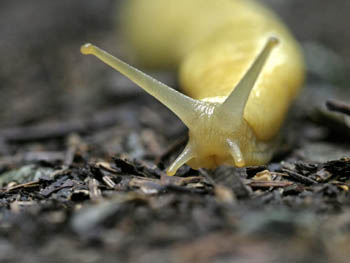Nature Notes by Dr. Frank Lang
A recent coast field trip reminded me of one of my favorite animals. In the redwoods we saw banana slugs, big, yellow, slimy banana slugs, some with spots, some without, but all with shiny coats that make your last head cold seem like nothing at all. Slugs and I go back a long way. One of my early memories is of Papa wandering around his beloved vegetable garden, salt-shaker in hand, searching for unfortunate, unwary slugs. The yard had strategically placed long, sharpened sticks for the same purpose, slug murder. Victims were mostly European immigrants that do the most damage in gardens. Our slugs met a somewhat painful end, not quick, like the slugs in the backyard of one of my former students. His mamma shot them from her kitchen window with a .22 caliber pistol.
My first major banana slug experience was as a graduate student at the University of British Columbia. I was working on fern cytology and wanted to count the chromosomes in the gametophyte, which have half the number of the root tips. The cell walls kept getting in the way. I read that some European workers used an enzyme from land snails’ stomachs to dissolve the cell walls so cells would flatten and chromosomes could be easily observed. I didn’t have snails, but I easily collected two gallons of live slithery, slimy banana slugs. I operated and collected 5 cc of stomach contents and pounds of slime. Imagine pouring out an entire jar of rubber cement and running your fingers through the puddle till it dried coating your hands and fingers in a thick, sticky layer. Slug enzyme did not work. Cell walls stayed intact, but not the slugs.

Banana slugs much prefer the damp, moist recesses of their native forest habitat to gardens. They eat most anything. Living plants, decaying plants, fungi, algae, lichens, dung, dead animals are all prized. They play a valuable role in forest ecosystems helping to recycle nutrients tied up in plant and animal bodies.
Banana slugs are shell-less, lunged mollusks. Scientists call them Ariolimax columbianus. They are found from southeast Alaska through northern California south to Santa Cruz. They are the second largest land slugs in the world, reaching a maximum length of ten inches. Only the European slug is larger.
Slugs glide along on a trail of slime on their muscular foot. Just behind their four tentacled sensory organs lies the saddle-like mantle that hides the anus and the genital opening. Between is a hole in the mantle that leads to a lung-like cavity that slugs open and close according to need.
Their sex life is enough to make the Marquis squirm. They are hermaphrodites. If you are a sensitive and highly refined sort, may not want to read the rest of this essay. Foreplay consists of a pair of slugs circling into a tight S-shape with much nudging, licking and biting. Then at the height of sluggly passion penetration of each into the other by members of prodigious size occurs. Sperm is exchanged and mutual fertilization follows. No cigarettes are smoked; however, there’s more. The prodigious penises get stuck and the only way to disconnect is by apophallation. They bite each others’ winkies off! After disentangling themselves, the battered and presumably exhausted slugs crawl off to lay their eggs to assure new slugs for future generations.
For all their strange, and to some, disgusting ways, banana slugs play a valuable ecological role. They are a grand example of a creature uniquely adapted to its way of life.
Thanks to Alice Bryant Harper for her book The Banana Slug.
— Dr. Frank Lang
Other pages in this section
- Dr Frank Lang obituary, May 14, 1937 – June 26, 2019
- Alkali Flies
- Bald Eagles
- Bull Trout
- Christmas Trees
- Cryptosporidiosis
- Cucurbits
- Dicamptodon
- Dippers
- Earthworms
- Fens
- Fishing
- Grapeferns
- Helliborine Orchid
- Habitat
- Hairy Woodpecker
- Hibernation
- Klamath Midge
- Marshes
- More Yellowjackets
- Morels
- Mosquito Fern
- Mountain Beaver
- Myriapods
- Painted Ladies
- Pandora Moths
- Pikas
- Pronghorns
- Raccoons
- Robins
- Shaggy Manes
- Silver-Gray Squirrels
- Soils
- Songbirds
- Spotted Owl
- Spotted Skunk
- Subalpine Fir
- Ticks and Mites
- Water
- Watermelon Snow
- Water Bears
- Wizard Island Toads
- Wocas
- Woodrats
- Yellowjackets
- Dr Frank Lang obituary, May 14, 1937 – June 26, 2019
- Alkali Flies
- Bald Eagles
- Bull Trout
- Christmas Trees
- Cryptosporidiosis
- Cucurbits
- Dicamptodon
- Dippers
- Earthworms
- Fens
- Fishing
- Grapeferns
- Helliborine Orchid
- Habitat
- Hairy Woodpecker
- Hibernation
- Klamath Midge
- Marshes
- More Yellowjackets
- Morels
- Mosquito Fern
- Mountain Beaver
- Myriapods
- Painted Ladies
- Pandora Moths
- Pikas
- Pronghorns
- Raccoons
- Robins
- Shaggy Manes
- Silver-Gray Squirrels
- Soils
- Songbirds
- Spotted Owl
- Spotted Skunk
- Subalpine Fir
- Ticks and Mites
- Water
- Watermelon Snow
- Water Bears
- Wizard Island Toads
- Wocas
- Woodrats
- Yellowjackets

